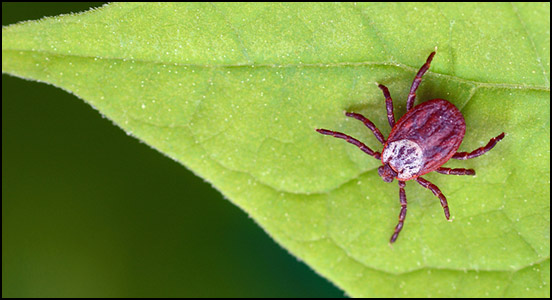
Tick Season Starts
Tick season has officially started, increasing the risk of Lyme disease and anaplasmosis.
The weather’s finally warm. The sun is out — and so are the ticks.
This year, tick season in Ohio is expected to be pretty bad, says Glen Needham, a retired entomologist and tick expert formerly with Ohio State University (OSU) Extension, the outreach arm of the College of Food, Agricultural and Environmental Sciences (CFAES) at OSU.
Already, Needham has collected the first black-legged or deer-tick nymph of the season in Coshocton County. It’s just the beginning of what people can expect to see as tick season ramps up, he says.
“With the extended winter cold we’ve experienced this year and the slower-to-develop spring weather, you can expect to see a lot of ticks starting to come out all at once,” Needham said. “Think of it as kind of a tick logjam.
“Although we’ve experienced a longer-than-normal winter, we really didn’t have a polar vortex come through and kill back the ticks, which typically are pretty cold-hardy.”
For example, soil temperatures have to reach zero to minus 5° Fahrenheit to freeze dog ticks, he said.
“So really, all the extended cold weather did was just delay tick emergence,” Needham said. “With these 70° and 80° days we’re now experiencing, ticks are going to be active and very hungry.”
With the rising tick population comes the risk of contracting tick-borne illnesses such as anaplasmosis, babesiosis and Lyme disease. Lyme disease is the major threat associated with deer-tick bites. Most Lyme disease cases occur during the summer when the poppy seed-sized nymphs are most active.
Lyme disease is caused by the bacterium Borrelia burgdorferi and is transmitted to humans through the bite of infected deer ticks, according to the Centers for Disease Control and Prevention (CDC).
Symptoms of Lyme disease, which can appear days to months after a tick bite, typically include fever, headache, neck stiffness, joint pain, facial palsy, heart palpitations, dizziness, fatigue and a characteristic skin rash.
Lyme disease and other arthropod-borne diseases spread by ticks, fleas and mosquitoes have tripled in the last 12 years, according to the Center for Disease Control and Prevention (CDC).
While Lyme disease can be treated with antibiotics, it can be an arduous, debilitating disease, Needham said.
The best way to beat Lyme disease is to prevent tick bites, he said. Use of veterinarian-recommended anti-tick products and Lyme vaccines are even more important with the expansion of infected tick populations.
“It’s important to know the kinds of ticks; how to prevent getting bit; and if you are bitten, how to remove them, considering that deer ticks have been reported in some 70 of Ohio’s 88 counties,” he said.
To learn more about ticks and how to keep people and animals safe, OSU Extension has developed a webinar and website with information about tick biology, tick identification and tick-borne diseases. The site can be accessed at u.osu.edu/tick/.

Editor’s Note: This article has been edited from a release by Tracy Turner, the technical editor for the Ohio State University College of Food, Agricultural and Environmental Sciences.






